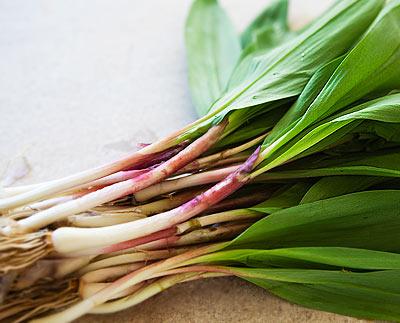 http://rusticrootsdelivery.com/rusticblog/spring-time-organic-delicacies/
http://rusticrootsdelivery.com/rusticblog/spring-time-organic-delicacies/
Last night, a friend posted a gorgoues picture of spring radishes on facebook and it started me thinking about wild ramp season! In fact, I'm so obsessed with wild ramps that I had dreams about them all night and I woke up starving! It's still early in February, and more snow is heading our way, but my half full cup says that it's almost Spring and what I'm dreaming about is a lovely trail ride through the woods with my favorite horse, Henry and my gathering basket, being seduced by the enticing flavor of the wild ramps that can can be found in early March through mid April! Wild ramps are a seasonal vegetable, that used to be found from late March to mid May depending upon where you live, but the last few years have found the effects of climate change beginning to change their growing season. If you've never tasted a wild ramp, trust me, you'll love them. The flavor is of a wild garlicky leek and like all edible members of the Allium family they have an immediate and pronounced tonic effect on our circulatory and immune systems. I love to use them in soups and stews, and have even been know to eat one or two of them raw with fresh sweet butter and bit of French sea salt. I love to add one or two of them to my juicer along with carrots, tomatoes, peppers, garlic and cucumber for my morning juice and this very same juice has been known to double as a perfect base for a Bloody Mary! I cook and puree them with asparagus, wild mushrooms and cream for a wonderful spring soup and I love to stuff them under the skin of a roasting chicken or toss them in the stock pot when I'm making bone broth!

If you're out in the woods you'll know that you've found a patch of them when your nose picks up a spicy garlicky aroma, amid the yummy fresh greens and sweet dirt smells of spring. They are beautiful plants with fleshy, vibrant green leaves and purple shoots that lead into a lovely familiar looking white bulb. When you're harvesting them just take a few of the shoots and leave the rest, trust me, a few is all you will need because the flavor is intense! If you don't have time to go find your own, the good news is that wild ramps will have been harvested for you by many of the wonderful Eastern farmers who have booths at the outdoor markets that begin in the Spring. That being said, it's a wonderful thing to happen upon a patch of wild ramps and a terrific excuse for a walk on the early spring forests but it's always important to remember to harvest any wild plant appropriately- here are a few tips!
A Few of my Rules About Harvesting Wild Foods!
Always make sure that you know what you are harvesting. Get a really good guide book, and if possible go with someone who knows how to distinguish between similar looking plants. Old farmers are usually a great source of information, but please leave wild mushroom harvesting to the pros!
Take a smaller amount than what you think you need and if possible gather from several different spots.
Always make sure that you have permission to gather on the land that you're foraging.
When you gather wild foods, make sure that you leave dirt on the roots, and keep a moist towel with you to wrap them in. I like to use cloth dishtowels, because I think that paper towels are too absorbent for the delicate roots.
Use a small hand cultivator to harvest your wild plants, and when you are choosing which plants to take, (as goofy as this may sound!) simply ask them! It's my experience that plants that are ready to be picked simply slide out of the earth more easily. If you get some real resistance, move on to the next one, and please don't pull on them so hard that they are damaged! There will always be one or two that will be happy to go home with you! A gentle tug is all that they need and then a light twist of your cultivator to help release them.
Like the Native Americans before us walk gently on the earth wherever you are and when you gather wild things please consider leaving something in return. The tradition of giving back to the earth is a very old one used by the Native Americans who were the first to farm this land. I've always got something in my pocket (corn, hay, a little bit of compost) to leave as a thank you when I take any plants from the wild. I know it sounds silly, but for me it completes the circle of harvest and life!

